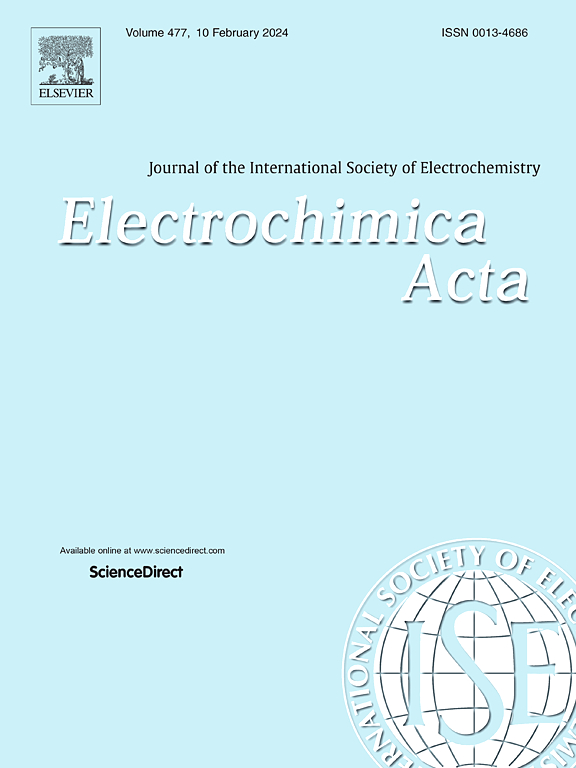用硼化芳基胺增强nmc111在高压高温下的稳定性
IF 5.5
3区 材料科学
Q1 ELECTROCHEMISTRY
引用次数: 0
摘要
本研究展示了硼化芳基胺作为高压高温LiNi1/3Mn1/3Co1/3O2 (NMC111)阴极的电解质添加剂,以提高电化学性能。利用电化学评价和物理表征研究了阴极和电解质的界面特性。与Li+/Li相比,添加剂在~ 3.8 V时发生氧化。4.5V充放电与不同c -倍率下Li+/Li的对比表明,2 mg/ml含添加剂电解质(MBA2)比基线(1.0 M LiPF6/EC:DEC)和其他含添加剂电解质具有更好的倍率能力。与MBA0(对照电解质)相比,MBA2电池在0.2C和1C条件下,在200次循环时的容量保持率分别为初始放电容量的77%和44%。电化学阻抗谱分析表明,在最佳浓度下,该添加剂有助于降低电荷转移和CEI电阻。60°C高温实验表明,在第100次循环时,MBA2的容量保持率为93%,而MBA0的容量保持率为89%。MBA2之所以具有优异的电化学性能,是由于含硼和氮的MBA形成了坚固、稳定的保护膜,这一点得到了物理表征的证明。该膜减缓了碳酸基电解质的连续分解,防止了高频在高压高温下循环时过渡金属离子从阴极析出的影响,证实了其在实际应用中的可行性。本文章由计算机程序翻译,如有差异,请以英文原文为准。

Enhancing Stability of NMC 111 at High Voltage/High Temperature Using Borylated Aryl Amines as Additive
The present study exhibited the use of borylated aryl amines, as an electrolyte additive for high voltage and high-temperature LiNi1/3Mn1/3Co1/3O2 (NMC111) cathode to improve electrochemical performance. The interfacial characteristics of cathode and electrolytes are investigated using electrochemical assessments and physical characterizations. The additive undergoes oxidation at ∼3.8 V vs. Li+/Li. Charge discharge at 4.5V vs. Li+/Li at varied C-rate shows that 2 mg/ml additive-containing electrolyte (MBA2) has better rate capability than baseline (1.0 M LiPF6/EC:DEC) and other additive-containing electrolytes. The MBA2 cell exhibits enhanced capacity retention at 0.2C and 1C with 77% and 44% of its initial discharge capacity, respectively at 200 cycles compared to MBA0 (control electrolyte). Electrochemical impedance spectroscopy reveals that the additive helps decrease the charge transfer and CEI resistance when employed at an optimum concentration. High-temperature studies at 60 °C showed better capacity retention of MBA2 with 93 % compared to MBA0 (89%) at the 100th cycle. The excellent electrochemical performance of MBA2 is attributed to the robust, stable and protective film formation of MBA containing boron and nitrogen species, which is demonstrated by physical characterization. This film mitigates the continuous carbonate-based electrolyte decomposition and prevents the effect of HF in transition metal ions dissolution from the cathode upon cycling at high voltage and temperature, confirming its feasibility in practical applications.
求助全文
通过发布文献求助,成功后即可免费获取论文全文。
去求助
来源期刊

Electrochimica Acta
工程技术-电化学
CiteScore
11.30
自引率
6.10%
发文量
1634
审稿时长
41 days
期刊介绍:
Electrochimica Acta is an international journal. It is intended for the publication of both original work and reviews in the field of electrochemistry. Electrochemistry should be interpreted to mean any of the research fields covered by the Divisions of the International Society of Electrochemistry listed below, as well as emerging scientific domains covered by ISE New Topics Committee.
 求助内容:
求助内容: 应助结果提醒方式:
应助结果提醒方式:


